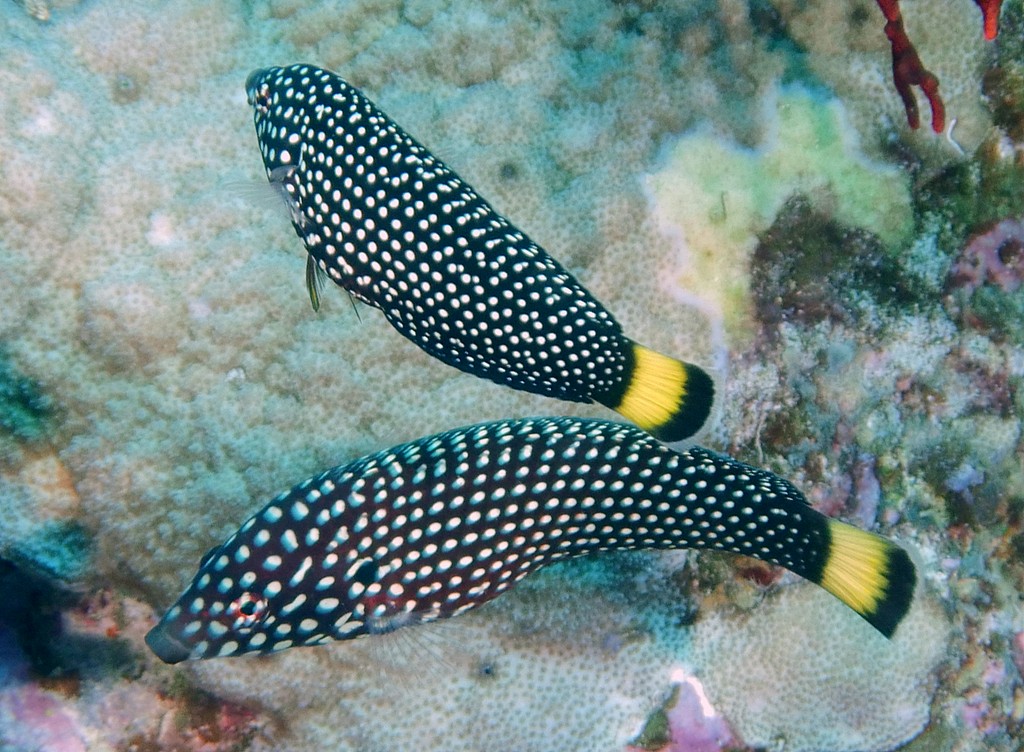ANAMPSES MELANURUS - (BLEEKER, 1857)
Picture courtesy of: Gloup Noumea
Actinopterygii (Gigaclass) > Actinopteri (Class) > Teleostei (Subclass) > Labriformes (Order) > Labroidei (Suborder) > Labridae (Family) > Anampses (Genus)
Labre à queue noire, Blacktail wrasse, New Guinea wrasse, White-spotted wrasse, Kurofuchi-susukibera, クロフチススキベラ, 乌尾阿南鱼, 烏尾阿南魚,
Description
Dorsal spines (total): 9; Dorsal soft rays (total): 12; Anal spines: 3; Anal soft rays: 12; Lateral line scales: 26; Gill rakers: 14-17. Caudal fin round. Long body, flat side. The mouth is small; The front of the upper and lower jaws each have a pair of protruding incisors, flat with cutting edges. The head has no scales in front of the eyes, the chest scales are not larger than the side of the body; The lateral lines are continuous. Max. length: 12.0 cm TL. Depth range: 15 - 40 m.
Color
Body color does not change much with age and gender of the fish, generally dark brown, with a white spot on each scale on the side of the body; White spots as large as pupils on the head; Yellow at the base of the tail fin, and a wide black back edge Band; A black round spot on the back edge of the operculum membrane.
Etymology
Anampses: from Greek verb, anakampto = to reflect, bend back. Hence, to bend back one's course, return. Refer to the peculiar shape of the four anterior teeth.
melanurus: from Latin, mélas = black, dark + from Greek, oura = tail. Rreferring to black distal margin of caudal fin.
Original description: Anampses melanurus Bleeker, 1857 - Type locality: Ambon Island, Molucca Islands, Indonesia.
Distribution
Eastern Indian Ocean, western Pacific: Central Indonesia east to Marshall, Marquesas and Society islands, north to Ryukyu and Ogasawara islands, south to northwestern Australia and New Caledonia.
Biology
Adults occur in seaward reefs. Also in deep coastal to outer reef slopes and drop-offs. Solitary or in pairs in the surge zone. They swim in small groups, each with several females and a single dominant male. Feed on small crustaceans, mollusks and polychaetes. Bury in sand at night. Oviparous, distinct pairing during breeding. Aquarium fish.
Similar species
Actinopterygii (Gigaclass) > Actinopteri (Class) > Teleostei (Subclass) > Labriformes (Order) > Labroidei (Suborder) > Labridae (Family) > Anampses (Genus)
Labre à queue noire, Blacktail wrasse, New Guinea wrasse, White-spotted wrasse, Kurofuchi-susukibera, クロフチススキベラ, 乌尾阿南鱼, 烏尾阿南魚,
Description
Dorsal spines (total): 9; Dorsal soft rays (total): 12; Anal spines: 3; Anal soft rays: 12; Lateral line scales: 26; Gill rakers: 14-17. Caudal fin round. Long body, flat side. The mouth is small; The front of the upper and lower jaws each have a pair of protruding incisors, flat with cutting edges. The head has no scales in front of the eyes, the chest scales are not larger than the side of the body; The lateral lines are continuous. Max. length: 12.0 cm TL. Depth range: 15 - 40 m.
Color
Body color does not change much with age and gender of the fish, generally dark brown, with a white spot on each scale on the side of the body; White spots as large as pupils on the head; Yellow at the base of the tail fin, and a wide black back edge Band; A black round spot on the back edge of the operculum membrane.
Etymology
Anampses: from Greek verb, anakampto = to reflect, bend back. Hence, to bend back one's course, return. Refer to the peculiar shape of the four anterior teeth.
melanurus: from Latin, mélas = black, dark + from Greek, oura = tail. Rreferring to black distal margin of caudal fin.
Original description: Anampses melanurus Bleeker, 1857 - Type locality: Ambon Island, Molucca Islands, Indonesia.
Distribution
Eastern Indian Ocean, western Pacific: Central Indonesia east to Marshall, Marquesas and Society islands, north to Ryukyu and Ogasawara islands, south to northwestern Australia and New Caledonia.
Biology
Adults occur in seaward reefs. Also in deep coastal to outer reef slopes and drop-offs. Solitary or in pairs in the surge zone. They swim in small groups, each with several females and a single dominant male. Feed on small crustaceans, mollusks and polychaetes. Bury in sand at night. Oviparous, distinct pairing during breeding. Aquarium fish.
Similar species
Anampses lineatus (Randall, 1972) - Reported from Red Sea; Indian Ocean: KwaZulu-Natal (South Africa), East Africa, Socotra (Yemen), Seychelles, Madagascar and Mascarenes (La Réunion, Mauritius, Rodrigues) east to western Indonesia.
Anampses meleagrides (Valenciennes, 1840) - Reported from New Caledonia - Link to the species (here). The primary phase of Anampses melanurus closely resembles that of Anampses meleagrides, but never has a uniformly yellow tail, and the color pattern does not change much with growth or sex.
Last update: 31, March 2023
